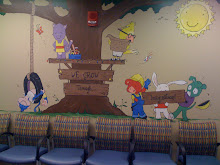Anyone can become dehydrated given the right circumstances. Children are more susceptible to dehydration because of smaller size and decreased ability to gain access to fluids. It is important for parents to
(1) recognize dehydration because it can be life threatening.
(2) know steps to take to avoid dehydration
(3) know when to call the office for evaluation
One of the most common causes of dehydration in children is vomiting and diarrhea. The child is not only losing precious fluids from both ends but usually feels too sick to take in any replacement fluids. This type of illness can create a deadly domino effect.
Parents can try to break the cycle by giving small amounts of fluid every 15-30 minutes. Fluids like Pedialyte for infants and Gatorade for older children are preferable. It is important that replacement fluids have the proper electrolyte balance especially if the child is refusing to eat. Fruit juices and other fluids high in sugar make diarrhea worse. Fluids like plain water and tea can upset the delicate balance of Sodium.
The urine output is a good indicator of hydration status. The urine output drops in order to preserve fluid. It is time to call the office when a noticeable drop in the urine output occurs. For an infant or small child no urine output in 4-8 hours warrants evaluation in the office or Emergency room. In an older child no urine output in 12 hours is worrisome. A dehydrated child will also start to appear drowsy and have no energy. Most children are active, energetic and alert normally. Dehydrated infants can often act irritable or have a sunken in soft spot
Prolonged or extremely high fever can also cause dehydration. Fever control and providing extra fluids is key in this situation.
Dehydration is treatable if caught early. Don't hesitate to call the office or seek medical attention if you think your child might be dehydrated.
This post was originally posted at www.waytoknowkids.wordpress.com
Friday, February 11, 2011
Saturday, February 5, 2011
SORE THROAT. Is it a virus or is it STREP?
Your child gets sent home from school complaining of a sore throat. Yesterday She was feeling fine with no symptoms at all. You look inside her mouth and see red spots like this:

Your next step is to call the office for an evaluation. A throat that looks like this is most likely STREP. But what if your child's throat looks like this:

Your next step is to call the office for an evaluation. A throat that looks like this is most likely STREP. But what if your child's throat looks like this:
This is a normal looking throat which is more often seen with a viral cause of sore throat. Sometimes the physical exam is not so obvious for STREP and a rapid STREP test is performed in the office. This office based test is highly accurate and sometimes a follow up throat culture is sent to a laboratory for confirmation.
STREP THROAT usually presents with a sore throat, fever , headache and stomach ache. The throat pain usually persists throughout the day. The symptoms usually come on rather quickly with the child often feeling fine the day before the main symptoms start.
A VIRAL SORE THROAT usually presents with runny nose, posterior drainage and sometimes a cough. The sore throat often is worse in the am and gets better as the day goes on. Viral symptoms tend to creep up on a patient with each day adding a new symptom.
Another cause of sore throat can be MONO. This is usually associated with extreme fatigue but not always. Usually there are also upper respiratory symptoms and aches. MONO tends to look like this:
We recommend coming in to the office for an evaluation to differentiate between the different causes of sore throat.
You can also find this post at www.WayToKnowKids.wordpress.com
Subscribe to:
Posts (Atom)


